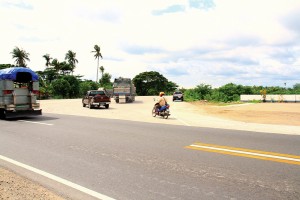DPWH to pave last 15,000 km of gravel roads
MANILA, Philippines—With a 2014 budget allocation of P129.41 billion, the Department of Public Works and Highways (DPWH) plans to rehabilitate the last 15,872 kilometers of gravel and unpaved arterial roads nationwide.
The amount is 67.7 percent of the agency’s total infrastructure program fund of P190.91 billion, according to a DPWH report, a copy of which was furnished the Inquirer by the agency’s Public Information Division.
The remaining P61.5 billion in capital outlays will go to major flood-control and other infrastructure projects in Metro Manila and the rest of the country.
This year’s budget for the rehabilitation of national roads and bridges is P28.48 billion more than last year’s, which was P110.93 billion.
Aside from the P129.4-billion funding, the government has set aside an additional P12.2 billion for the maintenance of roads and bridges and the installation of traffic lights and other road safety devices.
Article continues after this advertisementThe amount will be sourced from the P9.96-billion Special Road Support Fund, 80 percent of which will come from the Motor Vehicle User’s Charge; the P1.03-billion from the Special Road Safety Fund; and P1.21 billion from the Special Local Road Fund.
Article continues after this advertisementThe national road network, which is valued at P1.2 trillion, received budget allocations of P68.04 billion and P78.1 billion in 2011 and 2012, respectively.
At par with Indonesia, India
With increasing budgetary support, the DPWH has expressed confidence the Philippines’ global ranking in terms of quality of roads would improve further from the current 87th place in the World Economic Forum’s Global Competitiveness Report.
From 114th in 2010-2011, the country’s ranking improved by 27 notches in the WEF’s report for 2012-2013.
The department noted the nation’s road quality index had improved from 2.8 to 3.4, which makes it at par with Indonesia and India.
“The Philippines is targeting to be in the 4 to 5 territory by 2016,” the last year of the Aquino administration, said the DPWH.
Last September, the WEF said that overall, the country’s competitiveness ranking had improved by six notches to 59th from 65th the previous year.
Among the 10 Southeast Asian nations included in the body’s report, the Philippines placed sixth in terms of competitiveness, ahead of Vietnam, Laos, Cambodia and Myanmar.
However, it trailed Singapore, Malaysia, Brunei, Thailand and Indonesia.
In the WEF’s 2012-2013 report, roads in the country scored a mediocre 3.4 on a scale of 1 to 7, with 1 being extremely underdeveloped and 7 extensive and efficient by global standards.
Of 139 countries worldwide, the Philippines ranked 113th for the overall state of its public infrastructure, with particularly low marks for the quality of its airports and seaports.
Except for Vietnam, which scored a much lower 2.6, countries in the Southeast Asia garnered the following scores on the quality of their roads: Singapore, 6.5; Hong Kong, 6.2; South Korea and Japan, both 5.8; Malaysia, 5.7; Taiwan, 5.6; Thailand, 5; China, 4.4; Indonesia, 3.5; and India, 3.4.
Public Works Secretary Rogelio Singson called the upgrading of the quality and safety of the national road network “one of the DPWH’s priorities.”
He referred to the network as the “most important infrastructure asset of the government.”
Better drainage projects
In a recent agency planning session, Singson ordered the “pavement of all remaining gravel roads; improvement of the capacity of existing roads through road-widening projects; construction of bypasses where road widening is not feasible; and improving the quality of national highways through tighter supervision and quality assurance during the roads’ construction stage.”
On bridges, he said that “investments shall focus on the maintenance, if not replacement, of those that can no longer be rehabilitated to improve their condition, and the replacement of timber and bailey bridges with concrete or steel structures.”
To ensure the longer life span of primary roads, the DPWH head called for the “implementation of better drainage projects along these roads.”
